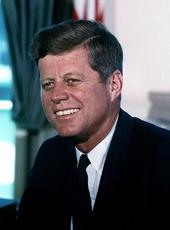Mr. Secretary, Mr. Minister, Madame, ladies and gentlemen:
I would like to repeat Mr. Malraux's last words which paid, I think, our country a singular compliment. He said, "There has been talk of the risks this painting took by leaving the Louvre. They are real, though exaggerated. But the risk taken by the boys who landed one day at Arromanches, to say nothing of those who preceded them 25 years before, were much more certain. To the humblest among them who may be listening to me now, I want to say without raising my voice that the masterpiece to which you are paying historic homage this evening, Mr. president, is a painting which he has saved." Mr. Minister, we are grateful to you.
Mr. Minister, we in the United States are grateful for this loan from the leading artistic power in the world, France. In view of the recent meeting at Nassau, I must note further that this .painting has been kept under careful French control, and that France has even sent along its own Commander in Chief, M. Malraux. And I want to make it clear that grateful as we are for this painting, we will continue to press ahead with the effort to develop an independent artistic force and power of our own.
Mr. Minister, this painting is the second lady that the people of France have sent to the United States, and though she will not stay with us as long as the Statue of Liberty, our appreciation is equally great. Indeed, this loan is the last in a long series of events which have bound together two nations separated by a wide ocean, but linked in their past to the modern world. Our two nations have fought on the same side in four wars during a span of the last 185 years. Each has been delivered from the foreign rule of another by the other's friendship and courage. Our two revolutions helped define the meaning of democracy and freedom which are so much contested in the world today. Today, here in this Gallery, in front of this great painting, we are renewing our commitment to those ideals which have proved such a strong link through so many hazards.
At the same time that the creator of this painting was opening up such a wide new world to Western civilization, his fellow countryman from Italy, Columbus, was opening up a new world to a new civilization. The life of this painting here before us tonight spans the entire life of that new world. We citizens of nations unborn at the time of its creation are among the inheritors and protectors of the ideals which gave it birth. For this painting is not only one of the towering achievements of the skill and vision of art, but its creator embodied the central purpose of our civilization.
Leonardo da Vinci was not only an artist and a sculptor, an architect and a scientist, and a military engineer, an occupation which he pursued, he tells us, in order to preserve the chief gift of nature, which is liberty. In this belief he expresses the most profound premises of our own two nations.
And therefore, Mr. Minister, we welcome this painting and all that it signifies, and particularly because we are grateful to the Government of France for sending not only one of her most cherished works of art, but also one of her most distinguished citizens. For M. Malraux has revived for our own age the Renaissance ideal of the many-sided man. In his own life as a writer, a philosopher, a statesman, and a soldier, he has again demonstrated that politics and art, the life of action and the life of thought, the world of events, and the world of imagination, are one, and it is appropriate that this Renaissance man comes to us as the friend and emissary of President de Gaulle, the leader who seized the opportunity for the rebirth of France and has given therefore the word "Renaissance" a new meaning for our age. We admire the vision of President de Gaulle, who has been able to weave from the rich heritage of France's past, the fabric of her future greatness and achievement. He has seen in the past the promise of the future, and has taken his place among those few statesmen of the West, who grasped the possibilities and the meaning of history, and thus were able to shape the ultimate course of our own society.
M. Malraux, I know that the last time the Mona Lisa was exhibited outside of Paris, in Florence, a crowd of 30,000 people packed the gallery on a single day, while large crowds outside smashed the windows. I can assure you that if our own reception is more orderly, though perhaps as noisy, it contains no less enthusiasm or gratitude.
It also is reported that on the same occasion as the Mona Lisa was carried through the streets to the Uffizi Gallery, people bared their heads as a homage to royalty. We here tonight, among them many of the men entrusted with the destiny of this Republic, also come to pay homage to this great creation of the civilization which we share, the beliefs which we protect, and the aspirations toward which we together strive.
NOTE: The President spoke before an invited audience in the West Statuary Hall at 9:30 p.m. In his opening words he referred to Secretary of State Dean Rusk, Andre Malraux, French Minister of Cultural Affairs, and Madame Malraux.
John F. Kennedy, Remarks at the National Gallery of Art Upon Opening the Mona Lisa Exhibition Online by Gerhard Peters and John T. Woolley, The American Presidency Project https://www.presidency.ucsb.edu/node/236879


